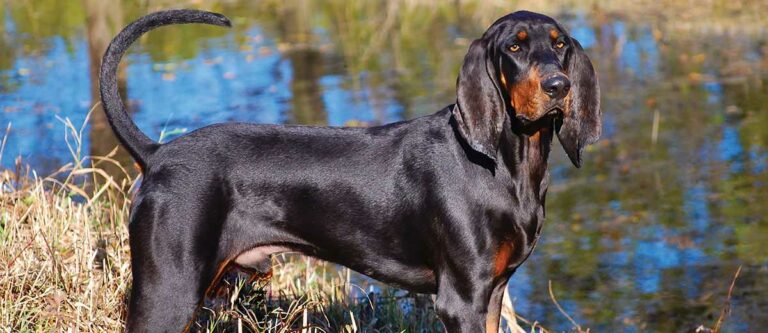American Black and Tan Coonhound Dog Breed Characteristics
The Black and Tan Coonhound stands out with its eye-catching black and tan coat and sturdy build. This breed has deep roots in the United States, where it became famous for its outstanding ability to track scents and hunt, especially when monitoring raccoons.
Known for being friendly and easy-going, Black and Tan Coonhounds, the first Coonhound breed, make great family dogs due to their gentle nature. They are there, referring to the first coonhound breed, the Black and Tan Coonhounds. Shiny black coats with tan markings and expressive faces are visually appealing.
Understanding the Tan Coonhound dog breed information and caring for a Black and Tan Coonhound requires understanding its needs and behaviors. Owners should be aware that this breed needs regular exercise and mental stimulation. They must also be mindful of common health issues the breed may face.
Proper care ensures health and happiness. Their long ears are a characteristic shared by the Redbone Coonhound, Bluetick Coonhound, and the first Coonhound breed, the Black and Tan Coonhound. are a distinct characteristic of this distinguished dog breed, the first Coonhound, the Black and Tan Coonhounds.
Key Takeaways
- Distinctive coat: Black and Tan Coonhounds sport a striking black and tan fur.
- Family-friendly: These dogs are known for a patient temperament.
- Exercise needs: They require regular activity for optimal health.
Black and Tan Coonhounds, originally from the United States, excel in scent tracking and hunting. They’re known for their patience and compatibility with families, featuring a shiny two-toned coat. Owners must ensure they stay active to maintain the well-being of a Black and Tan Coonhound, a breed descended from the American Foxhound, is essential.
Quick Facts
Standing tall at 23-27 inches for males and 21-25 inches for females, the Black and Tan Coonhound carries an impressive frame and weighs between 65-110 pounds. These dogs are known to live around 10-12 years. They are the picture of the classic American Black and Tan Coonhound, loved for their amicable nature and love for being around people. These traits make them great pets, and their hunting abilities are exceptional.
The Black and Tan Coonhound is honored to be the first to gain recognition from the American Kennel Club. This breed comes from a long line of hunting dogs built for the chase and the find. They’re friendly but need a lot of exercise and mental stimulation. People living in apartments must consider whether they can meet this breed’s needs.
In terms of health, this breed may be at risk for issues like hip dysplasia, tumors in the ears, and eye problems. Regular exercise, grooming, and a safe living environment are essential to keep these dogs healthy. The American Kennel Club offers resources such as AKC. TV and programs like CGC & AKC STAR Puppy to help owners train and care for their dogs responsibly.
Black and Tan Coonhound Dog Breed Pictures
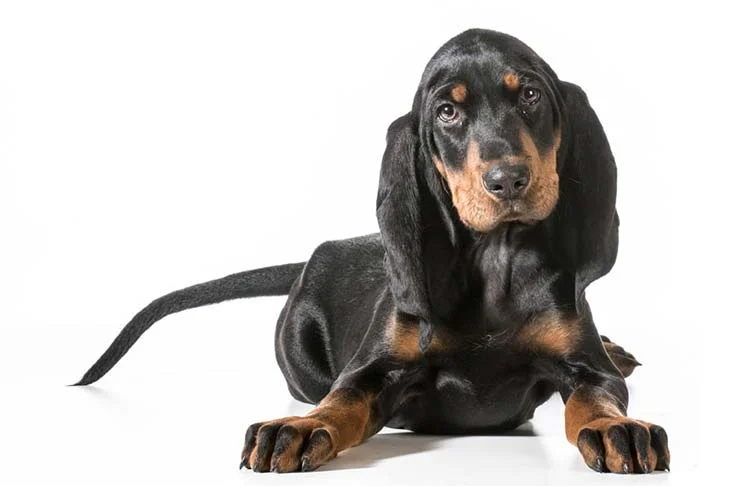
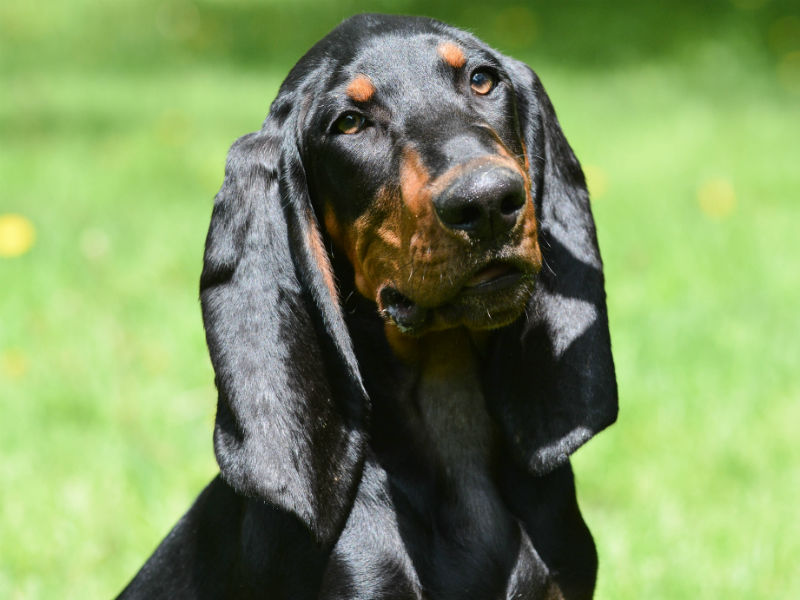
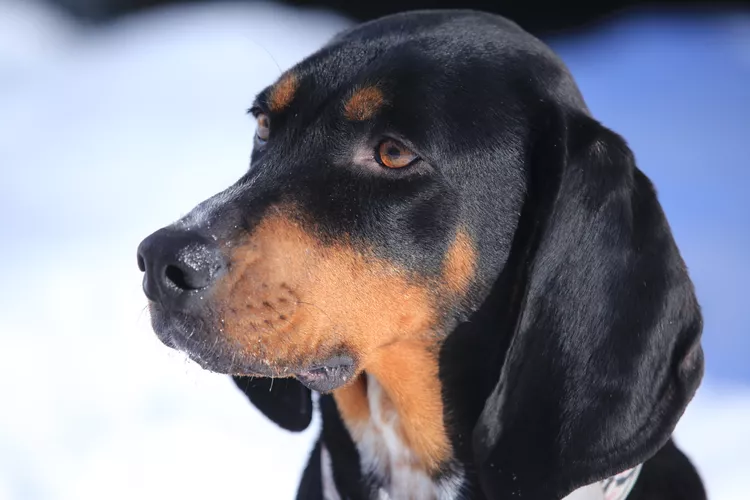
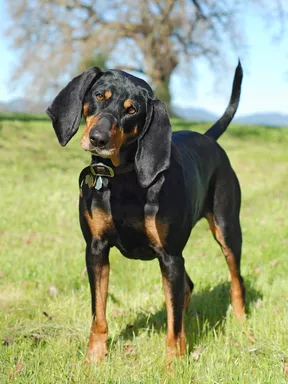
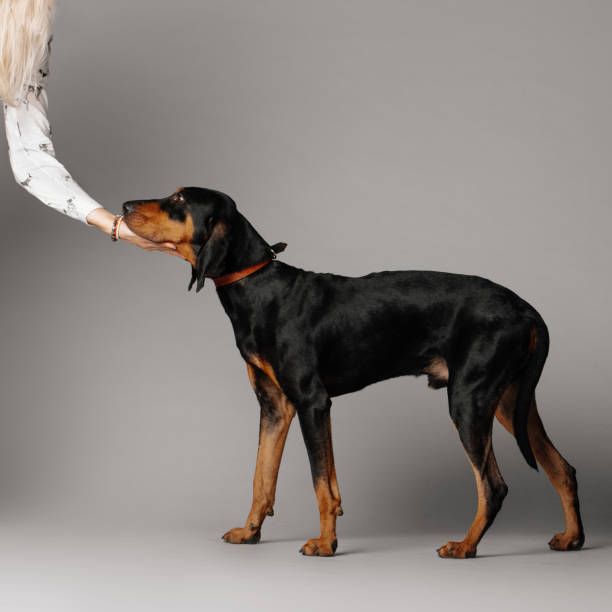
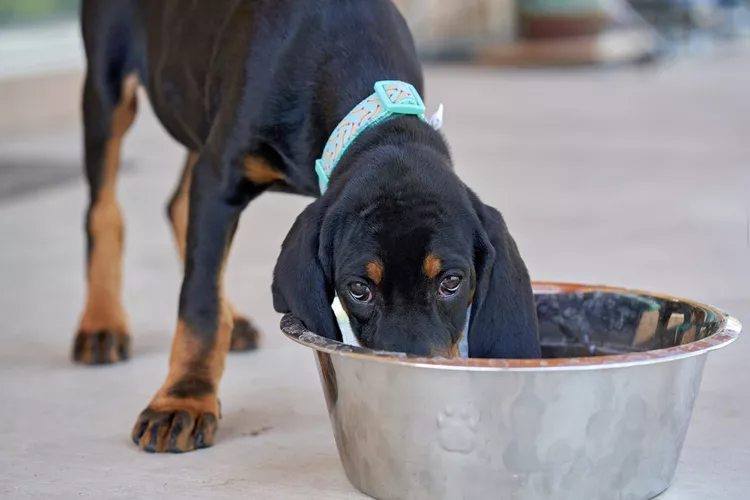
Overview of Black and Tan Coonhounds
The Black and Tan Coonhound is known for its durable build and friendly nature, making it a great hunter and a wonderful pet. This breed is particularly affectionate and fits nicely into family life. However, it has a strong instinct to chase, so keeping it on a leash and having a secure yard for play is essential.
These dogs can adapt to different living spaces, including apartments, but they need regular exercise to stay healthy and happy. They also require consistent grooming, like weekly brushing and occasional baths, to keep their coat in good condition.
Training a Black and Tan Coonhound can be tricky due to its independent nature. But with early socialization and consistent training, you can tap into the breed’s smarts and loyalty. Before getting one, it’s wise to talk to breeders, rescue groups, and other owners to ensure this breed is right for you. They need proper care and understanding to thrive.
Distinctive Markings Overview
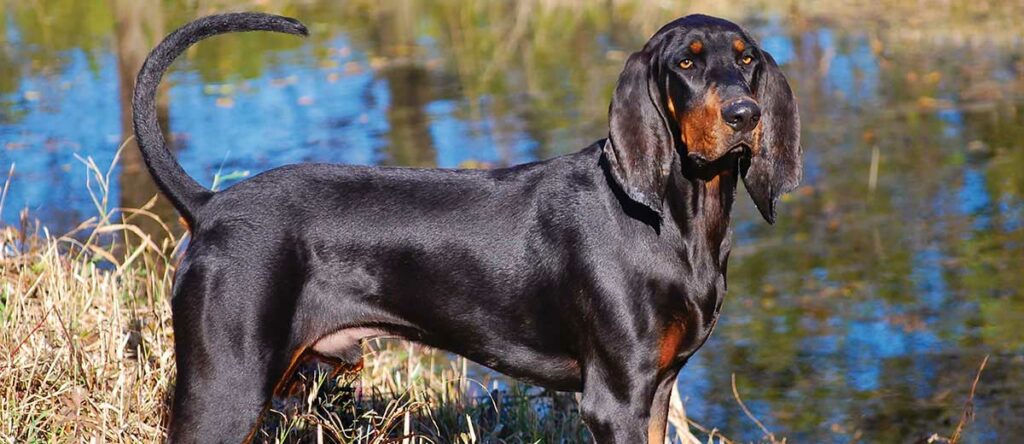
The Black and Tan Coonhound is known for its striking black and tan coat, a recognizable trait of this distinguished dog breed, the Redbone Coonhound and the Black and Tan Coonhound. These dogs have a color pattern that’s eye-catching and practical for nighttime hunting. The tan markings are found above the eyes, on the muzzle, chest, legs, and under the tail. These lighter areas stand out against the black coat, making it easier for hunters to spot their dogs in the dark.
Regular grooming is essential to keep the Black and Tan Coonhound’s coat shiny and to reduce shedding. This involves brushing and taking care of their ears and nails. Known for their excellent tracking abilities, these dogs are passionate hunters. They need plenty of exercise, socialization, and training to manage their instincts and to be wonderful pets.
Here’s a breakdown of their distinctive markings:
| Location | Color | Purpose |
|---|---|---|
| Above the eyes | Tan | Helps show emotions |
| Muzzle sides | Tan | Stands out against the black coat |
| Chest | Tan | It helps in signaling and spotting the dog |
| Legs | Tan | Emphasizes the dog’s athletic shape |
| Beneath the tail | Tan | Helps in signaling and spotting the dog |
The number 77 has no connection to the Black and Tan Coonhound’s appearance and is excluded from this description.
Origins in the 1700s
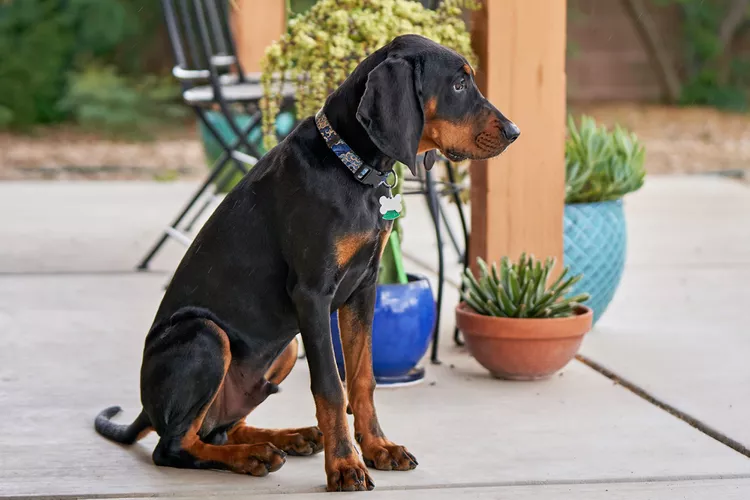
The roots of the Black and Tan Coonhound stretch back to the 18th century when early settlers brought ancestors of this breed to America for tracking and hunting purposes. This dog was specifically refined to thrive in the demanding American wilderness. These early dogs were bred for their exceptional ability to track scents and their stamina during extensive hunting trips.
- Breeders gave priority to developing the dogs’ scent-tracking skills.
- They were also crossed with dogs indigenous to America.
- The breed adapted to the varied American environments.
- Over time, breeders established consistent features for the Black and Tan Coonhound.
The breeding methods then aimed to produce a dog that could tirelessly follow a trail without getting worn out. The Black and Tan Coonhound was a versatile hunter, comfortable in different settings, from dense forests to mountainous areas. Breeders set specific standards to ensure the dogs met the desired attributes of a proficient hunting companion.
Breed Development Timeline
The Black and Tan Coonhound, an iconic American breed, emerged in the 1700s as a top hunting dog. Its, the first Coonhound breed’s, ancestry combines the Bloodhound’s keen scent-tracking abilities and the Foxhound’s agility, both descendants of the Talbot Hound. Such careful breeding produced a dog that excels at tracking small game like raccoons.
The breed gained a special place in American history when it was recognized by the American Kennel Club, highlighting its role in hunting traditions. This recognition solidified the Black and Tan Coonhound’s status as a significant breed in the United States.
Hunting Dog Heritage
Recognized by the American Kennel Club, the Black and Tan Coonhound has a rich history as an effective hunting dog that stretches back to the 18th century. Its skills in tracking and chasing wild animals became a fundamental part of hunting culture in the United States. This breed comes from a mix of foxhounds and bloodhounds and was developed to have the stamina to run long distances and the keen sense of smell to follow scents with unwavering focus.
The Black and Tan Coonhound’s sharp sense of smell and strong ability to vocalize was vital for hunters in finding and chasing raccoons and even larger animals like deer, bears, and cougars.
While the breed is calm and gentle at home, it still shows the independence and persistence needed for its traditional role in hunting. This requires an environment that supports its instincts and needs for regular physical activity.
Early Breed Influences
Since the 18th century, the Black and Tan Coonhound’s heritage, the first Coonhound breed, has been carefully shaped to create a dog skilled in tracking and treeing quarry with great speed and a unique deep bark.
Originating in the United States, this breed was significantly shaped by the Tan Virginia Foxhound and the Talbot hound, providing vital genetic building blocks. These early dogs gave the Black and Tan Coonhound a robust, muscular physique and impressive athletic ability.
Their intense hunting instincts and self-reliant characteristics were honed to meet the rigorous demands of persistent tracking and hunting.
Additionally, these forerunners influenced the breed’s well-rounded nature, resulting in a friendly and mild-mannered disposition with family members but a cautious approach to new faces.
They are also known for their loud calls, like baying and howling.
Breed’s Average Dimensions
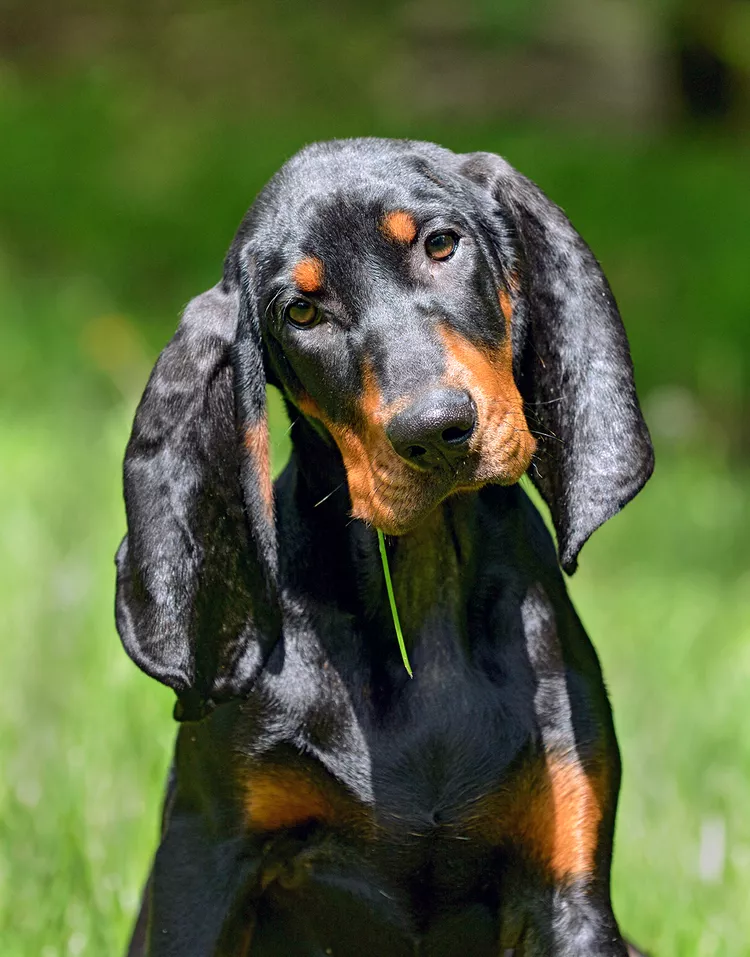
The Black and Tan Coonhound is known for its distinct physical features that suit it for hunting demands. These dogs display a range of heights at the shoulder, typically from 23 to 27 inches, which may vary according to whether the dog is male or female. Their weight also shows a broad spectrum, falling between 65 and 110 pounds, indicative of a larger-sized dog.
The proportion of the body, from the chest to the rump, is well-balanced, aiding in the dog’s physical harmony. From the time they are puppies until adulthood, Black and Tan Coonhounds grow consistently, generally reaching their full size by 12 to 14 months. This growth timeline is vital for understanding the developmental stages and ensuring the dogs meet their health and fitness needs.
Average Height Range
Male Black and Tan Coonhounds generally reach a height of 25 to 27 inches, while their female counterparts usually measure slightly shorter at 23 to 25 inches. These dogs showcase a robust and agile build belonging to the Hound Group.
There’s a clear size distinction between male and female dogs, which is typical due to their sexual dimorphism. Watching their diet and exercising is vital to avoid overweight issues that could harm their health and stature.
They’re sizable dogs, making a significant impact as lifelong pets, with an expected lifespan of 10 to 12 years. When measuring height for breed standards, the withers — the highest part of the back at the base of the neck — is the point of reference to maintain uniformity in size assessments.
Weight Classification
Considering the size of the Black and Tan Coonhound, it’s helpful to note that they typically weigh between 65 and 110 pounds. This places them firmly in the large dog category. The weight of a Black and Tan Coonhound is a critical factor in its overall well-being and ability to perform, especially when it comes to its traditional duties in outdoor activities like hunting and tracking.
Maintaining a healthy weight for this breed is essential, as obesity can lead to health issues such as hip dysplasia. This is a hereditary condition that’s more common in larger dogs and can result in discomfort and problems with movement.
A well-balanced diet and regular exercise are fundamental to keeping a Black and Tan Coonhound in shape.
Typical Body Length
Male Black and Tan Coonhounds typically stand between 23 and 27 inches high at the shoulder, while females usually range from 21 to 25 inches.
This dog breed has a body that is either square or a touch longer than tall. They have a balanced and moderate build well-suited for their role as scent hounds.
Their long ears and deep muzzle add to their noble look. They also have a short, dense coat that’s practical for outdoor work.
The breed moves with a smooth, effortless gait and has a keen, watchful expression. Their deep, resonant bark reflects their heritage as hunting dogs.
These features together create the distinctive look of the Black and Tan Coonhound.
Growth Rate
Understanding the physical traits of the Black and Tan Coonhound helps us to know how they grow and mature. Males usually reach a height of 23-27 inches, and females are a bit shorter, at 21-25 inches. Weights for this breed can vary a lot, ranging from 65-110 pounds. With a healthy growth rate, they’ll grow to fit these size ranges.
Since every dog is unique, some might grow at different speeds or grow slightly different in size. Black and Tan Coonhounds have a lifespan of 10-12 years, and they’re known for their large, athletic physique, typical of hunting dogs. Ensuring they get the proper nutrition and care is essential to stay healthy and active.
Size Comparison
The Black and Tan Coonhound is a sizable member within the Hound Group, with males standing at about 25-27 inches and females being a bit shorter, around 23-25 inches. They weigh quite a bit, typically between 65-110 pounds, showcasing their muscular frame built for endurance activities like tracking and hunting.
This breed’s build can be compared to their kin, the American English Coonhound, though that breed tends to be more slender.
These coonhounds have a life expectancy of 10-12 years, typical for dogs of their physical stature. Even with their larger size, they can adjust to different homes, including city apartments, as long as they exercise enough.
Breed Characteristics and Sociable Nature
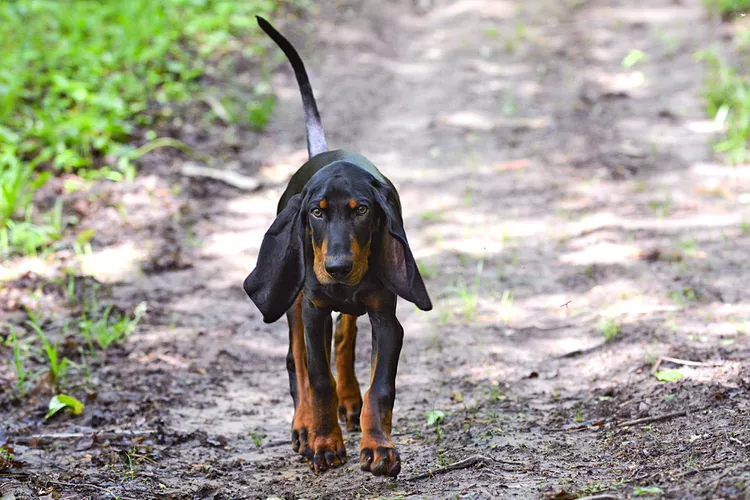
The social tendencies of Black and Tan Coonhounds are crucial for anyone considering welcoming one into their home. These dogs thrive on interaction with people and need to be part of family activities. Here’s what to keep in mind about their social nature:
- Black and Tan Coonhounds form strong bonds with their families and actively seek out company. Not giving them enough attention can lead to unwanted behaviors.
- Consistent socialization training is necessary to help them behave well in different situations. This helps them learn how to interact with people and other animals.
- While they usually get along with other pets, their relationships can vary. Each dog’s personality can influence how well they socialize with other animals.
- In public, expect them to remain calm and follow commands, even when distractions occur. Training helps maintain this good behavior outside the home.
Remember to provide these dogs with love and inclusivity in your daily life. Their happiness is closely tied to being part of your family’s activities.
Friendly Family Companion
Black and Tan Coonhounds are known for their friendly nature, which makes them perfect for families. Thanks to their laid-back character, they thrive on interaction with people and fit well into any home. These dogs are calm at home, which is great for living with kids and other animals. They are patient and can keep up with the energy of an active child.
Black and Tan Coonhounds also need exercise, which suits families who like staying active. They are a top choice for anyone looking for a friendly and loving dog.
Social Interaction Needs
Black and Tan Coonhounds are known for their warm nature and make excellent family pets due to their need for social interaction. These dogs enjoy being part of a busy household and bond well with humans, thriving on regular contact to stay happy. Their friendly and patient temperament makes them great around both kids and adults.
However, if left alone too much, they can become anxious. While they might be cautious around new faces, often expressing their wariness vocally, with proper socialization, they typically welcome new people and other pets in the home. This makes them a good fit for families with multiple animals.
Training for Sociability
Early socialization and obedience training are essential for Black and Tan Coonhounds to become friendly and confident around people and other animals. Start exposing them to various people and dogs early to encourage good behavior. Teach them basic commands like ‘sit,’ ‘stay,’ and ‘come’ to improve their responsiveness. Use rewards like treats and praise to reinforce good actions.
Regular leash training in different settings helps maintain proper behavior. Joining dog training classes can further improve their social skills and prepare them for teamwork in challenging roles.
Compatibility With Pets
Black and Tan Coonhounds are known for their friendly nature and get along well with other pets when introduced early and appropriately trained. Their strong hunting instincts mean they must be taught to behave around other animals from a young age.
While they are generally kind and patient, especially with kids and other house pets, it’s always best to watch them closely when they meet new animal friends. With the proper training and lots of love, these dogs can become loving parts of a multi-pet household and form close ties with other pets.
Public Behavior Expectations
Black and Tan Coonhounds are known for their friendly nature, which, with the proper socialization and training from a young age, leads to good behavior in public. They tend to be calm and well-behaved indoors, making them great companions for social situations. It’s important to start training and socializing early to help them act appropriately around people and in various settings.
These dogs have strong instincts to hunt, so using a sturdy leash is necessary to control their prey drive, especially if they pick up an attractive scent. Regular exercise and companionship help Black and Tan Coonhounds be happy and social around people and other pets. They need this to stay fit and enjoy being part of the community.
Common Health Concerns
Black and Tan Coonhounds, like all dog breeds, have specific health issues they’re more likely to develop. Owners must be proactive in their pets’ healthcare to reduce the chances of these problems and to help ensure their dogs live whole, healthy lives.
Understanding what can affect a Coonhound’s lifespan helps owners create a better living environment for their pets.
Hip Dysplasia is a common condition in many dogs, including Coonhounds, and it’s often passed down through genes. Owners should know this risk and discuss preventative strategies with their vet.
Regular ear checks are essential for Coonhounds, as they’re prone to ear infections due to their long, floppy ears. Keeping their ears clean can prevent discomfort and potential hearing loss.
Eye health is another area of concern for Black and Tan Coonhounds. Regular eye screenings can catch issues early on, which is vital for maintaining vision.
Knowing what factors affect a Coonhound’s longevity can help owners make choices that support their pet’s health. This includes a balanced diet, regular exercise, and routine vet visits.
Hereditary Health Issues
When looking at the health of Black and Tan Coonhounds, several inherited issues should be considered. These include hip dysplasia, hypothyroidism, cataracts, and a tendency for ear infections.
Hip dysplasia involves improper hip joint development, leading to pain and arthritis.
Hypothyroidism, with its low thyroid hormone levels, often causes dogs to become sluggish, put on weight, and have fur problems.
Cataracts cause the eye’s lens to be cloudy, leading to vision problems.
Due to their long, floppy ears, these dogs need regular ear care to avoid infections.
Ethical breeders will screen for these health problems to help ensure their puppies’ well-being and inform potential owners about the dogs’ health background.
Preventive Care Strategies
Understanding the genetic health risks common to Black and Tan Coonhounds is crucial for their well-being. Regular exercise and a well-rounded diet are vital to manage these risks and keep the breed healthy. Consistent vet visits are also an essential part of their health routine.
Preventing parasites is essential – treatments to ward off fleas, ticks, and heartworms should be regular. Oral care, including brushing teeth and getting dental check-ups, helps prevent gum disease. Since Coonhounds are prone to drooling, their faces should be cleaned often to avoid skin issues.
Socializing them early, keeping them mentally stimulated, and training them can help prevent behavioral issues. Watching their food intake is also important to avoid obesity and related health problems.
Lifespan Expectancy Factors
Black and Tan Coonhounds typically live for about 10 to 12 years. They are prone to health issues like hip dysplasia, ear cancer, and eye problems that can shorten their lifespan. Frequent cleaning around their mouth is necessary because this breed drools quite a bit. This helps prevent skin problems around their face.
Regular grooming is vital to avoid infections affecting their health, especially their ears. These dogs are usually between 55 and 75 pounds, so keeping them healthy is critical to avoid joint issues. Regular exercise and proper diet are essential. It’s also wise to watch for hip dysplasia and check their eyes regularly to catch any problems early.
Maintenance Essentials
Caring for a Black and Tan Coonhound involves a dedicated routine to keep them healthy and happy. Their care plan includes several critical elements that contribute to their overall well-being. Here are the main components that owners should focus on:
- Establish a regular grooming schedule to manage their shedding and keep their coat in top condition.
- Provide daily exercise to meet the breed’s energy levels and prevent behavior problems.
- Keep up with health check-ups and preventive measures through regular vet visits.
- Follow a nutritious diet that meets the specific requirements of the breed.
For the grooming of your Black and Tan Coonhound, it’s best to brush their coat weekly to reduce hair around the house and keep their fur shiny. Bathing them once every few months or as needed will help maintain their coat’s condition. It’s also important to regularly check and clean their ears to prevent infections, especially since they have long, floppy ears.
Physical activity is vital for this active breed. They thrive on having tasks to perform and space to roam, so long walks, hikes, or play sessions in a fenced yard are great ways to keep them fit. Dog sports and activities like tracking or agility can also stimulate the minds and bodies of this first Coonhound breed.
Regarding health, staying proactive with veterinary care is a must. Regular check-ups can catch potential health issues early. Vaccinations, flea, tick, and heartworm preventatives should be updated.
Feeding your Black and Tan Coonhound a well-balanced diet is crucial for their health. Choose a high-quality dog food that supports their size and activity level. Avoid overfeeding to prevent obesity, which can lead to health issues.
Grooming a Bluetick Coonhound or a Black and Tan Coonhound can be a task due to their dense coats. Due to their thick coats, a Bluetick Coonhound or a Black and Tan Coonhound can be a task. Routine
Maintaining a Black and Tan Coonhound involves a routine that keeps its coat and skin in top condition. These dogs have a short, dense coat that generally requires just a quick brush now and then. This helps to get rid of dead hair and keeps their look polished. But when they shed more, stepping up the brushing helps control the hair around your home.
Bath time for a Coonhound is an as-needed event. Use a gentle dog-specific shampoo on their skin to hold onto those essential oils. Their floppy ears need regular checks and cleanings to steer clear of infections. Their face, especially around the eyes, may require a daily wipe to stay clean.
It’s also crucial to trim their nails regularly to keep their paws pain-free and prevent any problems with walking.
Exercise Requirements
The Black and Tan Coonhound needs a good amount of exercise every day. Aim for a daily routine of 30 to 60 minutes to keep them happy and in good shape. A brisk walk or a steady run is perfect for these dogs, helping to maintain their muscle tone and keep their heart healthy.
Because they have a strong instinct to follow scents, keeping them on a leash or in a fenced area when exercising is safest. This way, they won’t run off after a smell that catches their attention.
Keeping these hounds physically active also keeps their minds sharp and helps prevent any trouble from them getting bored or having too much pent-up energy. Regular and structured activity time is critical to their physical and mental health.
Health Considerations
Maintaining the health and vitality of Black and Tan Coonhounds demands a consistent routine of exercise, grooming, dental hygiene, vet check-ups, and proper nutrition. These dogs need regular physical activity to keep their hearts healthy and minds sharp.
Grooming is crucial for their coat and skin health; regular brushing, baths, and nail trims can prevent skin problems. Their floppy ears should be cleaned often to avoid infections. Because they drool, brushing their teeth regularly and getting professional dental check-ups are essential to maintain good oral health.
Regular vet visits for shots and parasite prevention, along with a balanced diet and keeping an eye on their weight, are crucial to avoiding obesity and the health issues it can bring.
Exercise is a non-negotiable aspect of their care to prevent boredom and destructive behavior.
Grooming isn’t just about keeping them looking good and preventing painful mats and skin infections.
Dental care is more than just fresh breath; it’s about preventing tooth decay and gum disease that can lead to serious health problems.
Frequent vet check-ups help catch any potential health issues early on.
Managing their nutrition is critical to avoid overfeeding, which can lead to obesity and strain their joints and organs.
Diet Guidelines
A nutritious diet is vital to keeping Black and Tan Coonhounds healthy and full of vigor. Select a high-quality dog food that satisfies the breed’s nutritional needs, whether commercial or homemade.
Maintaining a healthy weight is essential, so keep an eye on their physique and adjust their diet to avoid obesity, a known issue in these dogs. Hand out treats sparingly to maintain a balanced diet and ensure they always have access to clean water.
To ensure your dog’s diet supports their well-being, seek advice from those with experience, such as long-time owners, trusted breeders, or local rescue organizations.
Training Strategies
Training a Black and Tan Coonhound requires a regular and straightforward strategy. This approach should include clear commands and consistent reinforcement to match the dog’s independent nature and specific training requirements. Introducing the Coonhound to various environments and scenarios early on helps them adapt and reduces the likelihood of future behavioral problems.
Using rewards like treats and verbal praise effectively encourages Coonhound’s cooperation. It is also beneficial to incorporate challenges for their active minds, such as puzzle toys and tracking activities. Ensuring they get plenty of physical activity is crucial for their overall health and helps them remain focused and manageable.
Consistency and positive reinforcement are key to training this intelligent breed. Providing them with mental stimulation and regular exercise is essential for their development. Following these guidelines can help raise a well-behaved and content Black and Tan Coonhound.
Nutritional Requirements
Ensuring the health and vitality of Black and Tan Coonhounds is essential, and it starts with their diet. These dogs need a diet that supports their active lifestyle and helps them maintain strong muscles.
Here’s what a nutritious diet for these hounds should include:
Protein from meat is vital for muscle repair and growth. Their food should contain a good amount of high-quality meat.
Fatty acids in the diet can contribute to the well-being of the Redbone Coonhound, which is related to the Black and Tan Coonhound. Omega-3 and omega-6 are essential for a shiny coat and healthy skin. It’s important to feed them a diet with the right fats.
They must manage their calories to avoid weight gain based on how much exercise they get.
Vitamins and minerals are also essential, supporting their immune system and keeping their metabolism in check.
Feeding Black and Tan Coonhounds is more than just giving them food; it’s about providing the proper nutrients for their needs. Tailoring the meals of a Black and Tan Coonhound to their exercise routine can help prevent obesity; it’s essential, mainly due to their active hunting lifestyle. Including various vitamins and minerals in their diet can keep their defenses strong against illnesses.
Balanced Diet Essentials
Ensuring Black and Tan Coonhounds maintain health and energy requires a nutritious diet. They need plenty of lean meats, fish, and eggs for protein intake, which supports their muscles and keeps them ready for daily activities. Whether on a stroll or enjoying a brisk jog, these dogs must consume the proper nutrients for their high energy demands.
Healthy fats are also necessary, especially those with omega-3 and omega-6 fatty acids in fish oil and flaxseed sources. These fats help keep their coat shiny and skin in good condition. It’s also beneficial to include a mix of fruits and vegetables in their diet to provide essential vitamins, minerals, and antioxidants that strengthen their immune system.
Whole grains and certain vegetables can be good sources of carbohydrates, helping with energy levels and keeping their digestive system running smoothly. Always ensure they have access to plenty of fresh water, especially after exercise, to stay properly hydrated.
Special Dietary Considerations
Black and Tan Coonhounds, renowned for their exceptional scent-tracking ability and sturdy health, need a diet monitored closely to suit their nutritional requirements and prevent health issues such as becoming overweight. Known as American Black and Tan Coonhounds, they do well on high-quality commercial dog food or meals prepared at home. It’s crucial to control their calorie intake to avoid excess weight, which can lead to health problems associated with obesity. Providing constant access to fresh water and limiting treats is essential.
Grooming for this breed is minimal, involving only occasional brushing. Still, they need their faces cleaned regularly to deal with drooling and their ears checked to avoid infections, vital for their overall health and diet.
Owners should always be mindful of their Black and Tan Coonhound’s diet and exercise routine. It’s not just about keeping them slim; a proper diet supports their active lifestyle and helps prevent health issues. Regular ear and face care also keeps these dogs happy and healthy.
Proper Feeding Practices
Understanding the dietary needs of Black and Tan Coonhounds is essential for their health. Their diet should match their life stage, activity level, and weight. It’s best to serve them high-quality dog food or a home-cooked meal approved by a vet. This ensures they get the proper nutrients.
Watch how much they eat to prevent weight gain. They should always have water available, and treats should be given in moderation. Regular check-ups with the vet help keep their diet suitable as they age.

